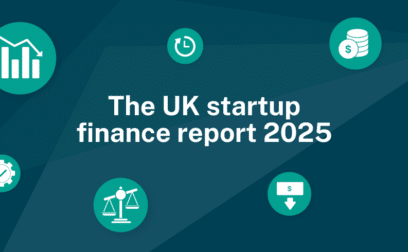TABLE OF CONTENTS
Under the super-deduction, for two years from 1 April 2021 any investments a UK business made in main rate plant and machinery qualified for a 130% capital allowance deduction.
Page written by Arabella McAvoy. Last reviewed on September 25, 2024. Next review due April 6, 2026.

Please note: this scheme has now expired and has been replaced by full expensing.
The super-deduction allowance was the most attractive tax incentive for business investment ever offered by a British government. Your company could claim back up to 25p for every pound you invest in ‘qualifying’ machinery and equipment for two years between April 2021 and March 2023.
From (then) Chancellor and current PM Rishi Sunak’s perspective, it was a “direct way to help businesses invest” and “drive growth in the economy”.
Between April 2021 and March 2023, any investments a business made in main rate (main pool) plant and machinery were eligible for a 130% capital allowance deduction.
There was also the added benefit of a 50% first-year allowance for qualifying special rate (including long life) assets – the Chancellor called this the ‘SR allowance’.
Both the 130% super-deduction and 50% first-year SR allowance were able to reduce corporation tax bills, because they gave qualifying equipment a much higher tax deduction in the tax year of purchase than would otherwise normally occur, i.e. the ‘first year allowance’ (FYA).
We explain more about what constituted ‘qualifying’ spending below.

A word from Andrea
"Super-deduction was undoubtedly the single biggest tax incentive any UK government has ever given for business investment into qualifying assets and equipment. Whilst not quite as generous as super-deduction, its successor, the full expensing scheme, is still very generous and worth taking advantage of - you can claim back 100% of the cost of plant, machinery, vehicles, office equipment, solar panels and more."
In a nutshell, the super-deduction tax break is intended to spur business investment, boost the UK’s post-pandemic economic recovery, and improve the country’s productivity levels.
This would in turn lead to more corporate profits for the government to tax in 2023.
Since the pandemic, previously low levels of business investment had fallen even further, with “a reduction of 11.6% between Q3 2019 and Q3 2020”, according to the Treasury’s super-deduction fact sheet. “Making capital allowances more generous works to stimulate business investment,” the Treasury explains. “As a result, these measures can promote economic growth and counter business cycles … The super-deduction will give companies a strong incentive to make additional investments, and to bring planned investments forward.”
The tax relief was introduced for two years for expenditure from 1 April 2021 to 31 March 2023.
How did it work? Let’s look at the 130% first-year relief on qualifying main rate plant and machinery investments made during this period. Here’s an example:
Let’s say your business spends £100,000 on main rate equipment and you’re eligible to claim the super-deduction tax break on this expenditure.
When you calculate your taxable profits your corporate tax deduction will be £130,000 (i.e. 130% of your initial investment). Deducting £130,000 from your taxable profits will save your business up to 19% of that – 19% of £130,000 is £24,700. And that’s how much corporation tax you save if you qualify for super-deduction.
Bear in mind that this is a 130% deduction for investments that would normally qualify for 18% plant and machinery writing down allowances (or capital allowances). And the first-year allowance of 50% on special rate pool expenditure would normally only attract 6% writing down allowances.
From an accounting perspective, our advice for businesses looking to maximise your tax savings is to plan well ahead.
We’ve given an example above of how the super-deduction can apply to main rate expenditure. The SR allowance works in a similar way to the super-deduction.
Here’s how you might calculate your tax savings on special rate pool expenditure:
Let’s say you spend £1m on assets that don’t qualify for the main pool – perhaps integral features of a building, or assets that have an expected life of more than 25 years.
In the first year the SR allowance gives you a tax deduction of £500,000 to offset against your corporation tax profits. This will give you a tax deduction of 19% of this sum, i.e. £95,000, off your tax bill. You will obtain tax deductions in the subsequent years in the usual way for the remaining £500,000 of capital allowances at 6% per annum.
Yes, probably.
The Chancellor has confirmed the extension to the £1m annual investment allowance (AIA) until 31 December 2021. So the AIA is available alongside the SR allowance and super-deduction.
The AIA gives 100% tax relief for costs of qualifying plant and machinery in the year of purchase. In other words you can deduct the full value of an item that qualifies for AIA from your profits before tax, for financial expenditure on up to £1m of qualifying plant and machinery.
Now, since the SR allowance is only 50%, it will probably make sense for you to allocate the AIA against your first £1m of special rate assets, because you can claim a 100% deduction rather than 50%.
How does AIA work? Let’s say you spend £1m on integral features of a building. The AIA gives you a tax deduction of £1m against your corporation tax profits. At the prevailing corporation tax rate of 19% this gives you £190,000 off your corporation tax bill.
Best of all, the AIA does not give rise to a balancing charge when you dispose of assets (see ‘What are the pitfalls…’ below).
So, the only case where you’d be better off claiming the SR allowance rather than the AIA would be if you spend more than £1m on special rate pool additions (not including cars!)
Be aware that the Chancellor’s generosity might have a sting or two in the tail.
Despite obtaining a 130% or 50% up-front deduction you will need to track your assets for capital allowances purposes, so that you make sure they are given the right tax treatment at the time of disposal.
On disposal of main pool items you will automatically suffer a balancing charge (i.e. you’ll be taxed on the sales proceeds) rather than taking the proceeds to the relevant capital allowances pool as you would without these new allowances. On disposal of special rate pool items you will suffer a balancing charge of 50% of the proceeds – the other 50% will be deducted from the special rate pool.
The timing matters. If the date of disposal is after 1 April 2023 then the 25% corporation tax rate applies to the balancing charge. For main rate pool items you will have obtained tax relief of 24.7% (130% of 19%). For special rate pool items your relief was only at 19%, but as you would normally expect to keep them for some years this is probably not going to prevent you from incurring the expenditure.
Where the date of disposal is prior to 1 April 2023 and you claimed a super-deduction, the disposal value you bring into account is 1.3 times the actual disposal value.
Like all other capital allowances, any deductions that you cannot use in the current year can be carried forward as tax losses to future years. For example, if you spend £1m on computer equipment you obtain a super-deduction of £1.3m. If your profits before capital allowances are £100,000 you therefore have excess losses of £1.2m to carry forward to use against profits in subsequent years. Again, you will have to forecast in order to determine whether either the capital allowances pool or your tax losses would be more beneficial in your business. Your accountant will be able to help you with this.
The super-deduction and the SR allowance don’t apply to partnerships or individuals.
You need to have a company to get these valuable reliefs.
No, you can’t claim super-deduction if you’re a sole trader. The super deduction and SR allowance are available only to companies that are subject to corporation tax, and are not available to individuals, partnerships or LLPs. This is because the super deduction and SR allowance are available only to companies that are subject to corporation tax.
Your business is eligible if you spend money on any of the assets listed below between April 1 2021 and March 31 2023.
In other words, for what equipment can I claim the super-deduction or the SR allowance?
Not all business investments will qualify for the new allowances, but the qualifying groups are quite wide:
Bear in mind that that certain expenditure is excluded, for example, the acquisition of company cars, as well as the purchase of second-hand plant and machinery.
In the draft super-deduction legislation (published on 3 March 2021) plant and machinery investment incurred under “a hire purchase or similar contract” has to meet “additional conditions” to qualify for the super-deduction.
Some people have inferred that the 130% tax break therefore excludes hire purchase (or asset finance arrangements more broadly). In fact, in a scenario where your company makes payments in order to acquire an asset, and where there is an expectation that legal ownership of the asset will at some point pass to you (i.e. the lessee, as it typically the case with hire-purchase agreements), the super-deduction should be available to you. But you need to be aware of the anti-avoidance provisions that apply to, for example, contrived arrangements, agreements with connected parties, and second-hand assets. And there is a clawback of the tax saving if your business disposes of the asset prior to 1 April 2023.
The super-deduction and the SR allowance don’t apply to partnerships or individuals. You need to have a company to get these valuable reliefs.
No, you need to have spent the money during the time period specified, i.e. between 1 April 2021 and 31 March 2023.
Register with Swoop to discover your options and speak with our funding experts.
Written by
Arabella is a former BBC business journalist who began her career as a policy analyst at the Bank of England and Financial Conduct Authority, and more recently worked in the communications and policy team at the British Business Bank.
Swoop promise
At Swoop we want to make it easy for SMEs to understand the sometimes overwhelming world of business finance and insurance. Our goal is simple – to distill complex topics, unravel jargon, offer transparent and impartial information, and empower businesses to make smart financial decisions with confidence.
Find out more about Swoop’s editorial principles by reading our editorial policy.
Other government support pages
Get your free Super-deduction quote today
Join the 110,000+ businesses just like yours getting the Swoop newsletter.
Free. No spam. Opt out whenever you like.



























We work with world class partners to help us support businesses with finance
Kingfisher Way, Silverlink Business Park, Newcastle upon Tyne, NE28 9NX, UK
View in Google MapsAberystwyth Innovation and Enterprise Campus
Gogerddan Campus
Aberystwyth University
Ceredigion
SY23 3EE
Dogpatch Labs, The CHQ Building, Custom House Quay, Dublin, Ireland
View in Google MapsSuite 801, Level 8, 84 Pitt Street, Sydney, NSW 2000, Australia
View in Google Maps43 W 23rd St, New York, NY 10010, United States
View in Google Maps21 Dreyer Street, Cape Town, South Africa, 7708
View in Google Maps
Disclaimer: Swoop Finance helps UK firms access business finance, working directly with businesses and their trusted advisors. We are a credit broker and do not provide loans or other finance products ourselves. We can introduce you to a panel of lenders, equity funds and grant agencies. Whichever lender you choose we may receive commission from them (either a fixed fee of fixed % of the amount you receive) and different lenders pay different rates. For certain lenders, we do have influence over the interest rate, and this can impact the amount you pay under the agreement. All finance and quotes are subject to status and income. Applicants must be aged 18 and over and terms and conditions apply. Guarantees and Indemnities may be required. Swoop Finance can introduce applicants to a number of providers based on the applicants’ circumstances and creditworthiness. Swoop Finance Limited is registered with the Financial Conduct Authority as an Account Information Services Provider (reference number 833145). Swoop Finance Limited is authorised as a credit broker under FCA registration number 936513. If you feel you have a complaint, please read our complaints section highlighted above and also contained within our terms and conditions. Swoop Finance Ltd is registered with Companies House (company number 11163382, registered address The Stable Yard, Vicarage Road, Stony Stratford, Milton Keynes MK11 1BN). VAT number: 300080279
Clever finance tips and the latest news
Delivered to your inbox monthly
Join the 110,000+ businesses just like yours getting the Swoop newsletter. Free. No spam. Opt out whenever you like.
Thanks for requesting a call back
a member of the team will be in touch.




